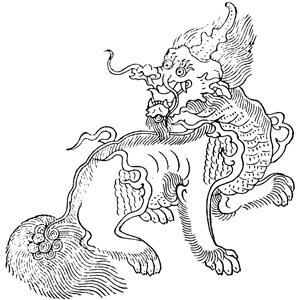Keyword: Horn
Xiezhi (Chinese: 獬豸)or Haetae ( Haetae, often spelled Haitai or Haechi) is a legendary creature in Chinese and Korean mythology. In Chinese literature it can be traced back to the Han Dynasty(206 BC-220 AD), where it is described by the scholar Yang Fu as a "righteous beast, which rams the wrong party when it sees a fight, and bites the wrong party when it hears an argument". It is also described in the Shuowen Jiezi(《说文解字》) as being "a cattle-like beast with one horn; in ancient times, it settled disputes by ramming the party at fault".
As an inherently just beast, the Xiezhi was used as a symbol of justice and law. The Censorate of the Ming and Qing eras, who were responsible for the monitoring of the civil service, wore the Xiezhi as a badge of office. Similarly, military policemen of the Republic of China wear badges bearing the Xiezhi, and it is engraved on the gavels in the law courts of the People's Republic of China.
Xiezhi (Chinese: 獬豸)or Haetae ( Haetae, often spelled Haitai or Haechi) is a legendary creature in Chinese and Korean mythology. In Chinese literature it can be traced back to the Han Dynasty(206 BC-220 AD), where it is described by the scholar Yang Fu as a "righteous beast, which rams the wrong party when it sees a fight, and bites the wrong party when it hears an argument". It is also described in the Shuowen Jiezi(《说文解字》) as being "a cattle-like beast with one horn; in ancient times, it settled disputes by ramming the party at fault".
As an inherently just beast, the Xiezhi was used as a symbol of justice and law. The Censorate of the Ming and Qing eras, who were responsible for the monitoring of the civil service, wore the Xiezhi as a badge of office. Similarly, military policemen of the Republic of China wear badges bearing the Xiezhi, and it is engraved on the gavels in the law courts of the People's Republic of China.
According to Korean records, Haetae's body is shaped like a lion and has a horn on its forehead. It has a bell in its neck, and the body is covered with scales. It lives in the frontier areas of Manchuria. In ancient Korea, Haetae sculptures were used in architecture during the early Joseon dynasty, as their image was trusted to be able to protect Hanyang (now Seoul) from natural disasters and to give law and order among the populace. Seoul city has officially used Haechi (origin of Haetae) as the symbol of Seoul since 2009.
In English, it is called "the Unicorn-lion" or "an omniscient mythical beast".
Whereas in the West culture the unicorn is a legendary animal that has been described since antiquity as a beast with a large, pointed, spiraling horn projecting from its forehead. The unicorn was depicted in ancient seals of the Indus Valley Civilization and was mentioned by the ancient Greeks in accounts of natural history by various writers, including Ctesias, Strabo, Pliny the Younger, and Aelian. The Bible also describes an animal, the re'em, which some translations have rendered with the word unicorn.
Whereas in the West culture the unicorn is a legendary animal that has been described since antiquity as a beast with a large, pointed, spiraling horn projecting from its forehead. The unicorn was depicted in ancient seals of the Indus Valley Civilization and was mentioned by the ancient Greeks in accounts of natural history by various writers, including Ctesias, Strabo, Pliny the Younger, and Aelian. The Bible also describes an animal, the re'em, which some translations have rendered with the word unicorn.
In European folklore, the unicorn is often depicted as a white horselike or goatlike animal with a long horn and cloven hooves (sometimes a goat's beard). In the Middle Ages and Renaissance, it was commonly described as an extremely wild woodland creature, a symbol of purity and grace, which could only be captured by a virgin. In the encyclopedias its horn was said to have the power to render poisoned water potable and to heal sickness. In medieval and Renaissance times, the horn of the narwhal was sometimes sold as unicorn horn.
References



没有评论:
发表评论